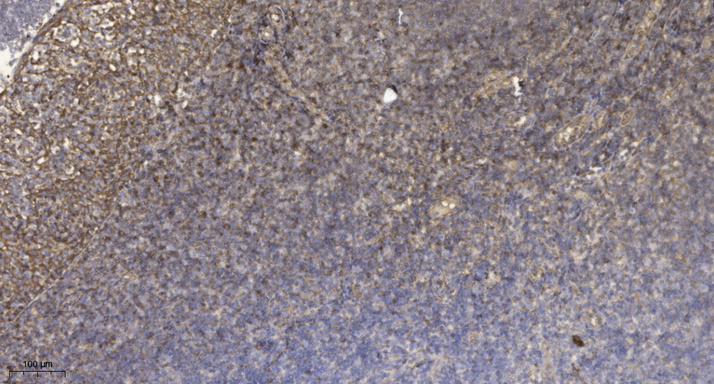HtrA2 (phospho Ser142) Polyclonal Antibody
- Catalog No.:YP1118
- Applications:IHC;IF;ELISA
- Reactivity:Human;Mouse;Rat
- Target:
- HtrA2
- Fields:
- >>Apoptosis;>>Apoptosis - multiple species;>>Parkinson disease;>>Pathways of neurodegeneration - multiple diseases
- Gene Name:
- HTRA2
- Protein Name:
- Serine protease HTRA2 mitochondrial
- Human Gene Id:
- 27429
- Human Swiss Prot No:
- O43464
- Mouse Gene Id:
- 64704
- Mouse Swiss Prot No:
- Q9JIY5
- Immunogen:
- Synthesized phospho-peptide around the phosphorylation site of human HtrA2 (phospho Ser142)
- Specificity:
- Phospho-HtrA2 (S142) Polyclonal Antibody detects endogenous levels of HtrA2 protein only when phosphorylated at S142.
- Formulation:
- Liquid in PBS containing 50% glycerol, 0.5% BSA and 0.02% sodium azide.
- Source:
- Polyclonal, Rabbit,IgG
- Dilution:
- IHC 1:100 - 1:300. ELISA: 1:40000.. IF 1:50-200
- Purification:
- The antibody was affinity-purified from rabbit antiserum by affinity-chromatography using epitope-specific immunogen.
- Concentration:
- 1 mg/ml
- Storage Stability:
- -15°C to -25°C/1 year(Do not lower than -25°C)
- Other Name:
- HTRA2;OMI;PRSS25;Serine protease HTRA2; mitochondrial;High temperature requirement protein A2;HtrA2;Omi stress-regulated endoprotease;Serine protease 25;Serine proteinase OMI
- Molecular Weight(Da):
- 49kD
- Background:
- This gene encodes a serine protease. The protein has been localized in the endoplasmic reticulum and interacts with an alternatively spliced form of mitogen-activated protein kinase 14. The protein has also been localized to the mitochondria with release to the cytosol following apoptotic stimulus. The protein is thought to induce apoptosis by binding the apoptosis inhibitory protein baculoviral IAP repeat-containing 4. Nuclear localization of this protein has also been observed. Alternate splicing of this gene results in multiple transcript variants encoding different isoforms. [provided by RefSeq, Mar 2016],
- Function:
- catalytic activity:Cleavage of non-polar aliphatic amino-acids at the P1 position, with a preference for Val, Ile and Met. At the P2 and P3 positions, Arg is selected most strongly with a secondary preference for other hydrophilic residues.,disease:Defects in HTRA2 are the cause of Parkinson disease type 13 (PARK13) [MIM:610297, 168600]. Parkinson disease (PD) is a complex, multifactorial disorder that typically manifests after the age of 50 years, although early-onset cases (before 50 years) are known. PD generally arises as a sporadic condition but is occasionally inherited as a simple mendelian trait. Although sporadic and familial PD are very similar, inherited forms of the disease usually begin at earlier ages and are associated with atypical clinical features. PD is characterized by bradykinesia, resting tremor, muscular rigidity and postural instability, as well as by a clinically
- Subcellular Location:
- Mitochondrion intermembrane space. Mitochondrion membrane ; Single-pass membrane protein . Predominantly present in the intermembrane space. Released into the cytosol following apoptotic stimuli, such as UV treatment, and stimulation of mitochondria with caspase-8 truncated BID/tBID.; [Isoform 1]: Endoplasmic reticulum .
- Expression:
- [Isoform 1]: Ubiquitously expressed.
- June 19-2018
- WESTERN IMMUNOBLOTTING PROTOCOL
- June 19-2018
- IMMUNOHISTOCHEMISTRY-PARAFFIN PROTOCOL
- June 19-2018
- IMMUNOFLUORESCENCE PROTOCOL
- September 08-2020
- FLOW-CYTOMEYRT-PROTOCOL
- May 20-2022
- Cell-Based ELISA│解您多样本WB检测之困扰
- July 13-2018
- CELL-BASED-ELISA-PROTOCOL-FOR-ACETYL-PROTEIN
- July 13-2018
- CELL-BASED-ELISA-PROTOCOL-FOR-PHOSPHO-PROTEIN
- July 13-2018
- Antibody-FAQs
- Products Images

- Immunohistochemical analysis of paraffin-embedded human tonsil. 1, Antibody was diluted at 1:200(4° overnight). 2, Tris-EDTA,pH9.0 was used for antigen retrieval. 3,Secondary antibody was diluted at 1:200(room temperature, 30min).



